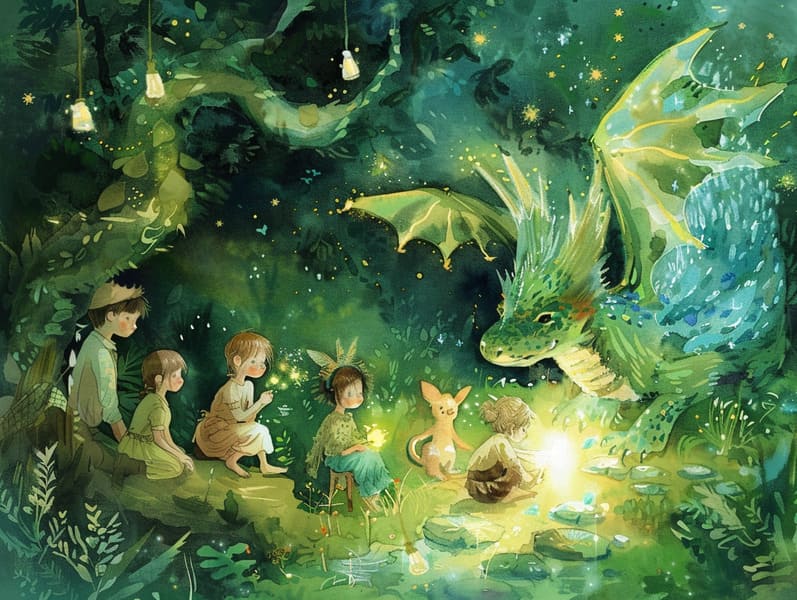A Brief History of Fairy Tales to Read and Their Endless Fascination.
A Brief History of Fairy Tales to Read and Their Endless Fascination.
Blog Article

Old fairy tales have historical significance. These narratives have been conveyed from one generation to the next long before they were ever written down. They sprang from a variety of traditions, including Western traditions. They were initially disseminated among older generations, often carrying themes and messages concerning the societal norms and beliefs of the time.
The Grimm brothers, the two Grimm brothers, were among the first to assemble many of these beloved fairy tales. Their volume, "Grimm's Fairy Stories," included narratives like "The Little Glass Slipper," "The Story of Hansel and Gretel," and "Little Snow White," which have since become mainstays in the world of children's fairy tales. Similarly, Hans Christian Andersen's fanciful fairy tales, such as "The Mermaid's Tale," and "The Ugly Duckling," have won hearts worldwide, securing their place in the pantheon of treasured fairy tales.
Despite their age, traditional fairy tales remain as important as ever, especially as kids' bedtime tales. These whimsical stories are now available in different formats, including vividly illustrated books, whimsical animations, and digital storybooks.
Their ongoing significance can be linked to several delightful features:
Significant Morals: Traditional fairy tales often impart important moral lessons. Narratives like "The Boy Who Cried Wolf" teach the benefit of integrity, while "The Hare and the Tortoise" emphasize the values of resolve and meekness. These tales offer little ones clear distinctions between moral and immoral, building their moral compass in a mild yet deep way.
Sympathy and Perception: Ancient fairy tales frequently involve protagonists facing tests and troubles, provoking young listeners to comprehend with their struggles and cheer for their triumphs. For instance, "Beauty and the Beast" shows us the necessity of looking past the exterior to know the true nature of a person, fostering warmth and appreciation.
Cultural Knowledge: Many traditional fairy tales are infused with the cultural contexts from which they originated. Immersing in these tales can provide intriguing perspectives into different cultures, nurturing a sense of world insight and knowledge.
Imagination and Creativity: The supernatural elements in traditional fairy tales—enchanted forests—enhance children’s innovative ideas. These stories lead readers to supernatural realms, awakening imaginative dreams and a sense of awe that remains a lifetime.
Classic fairy tales are not only entrancing but also instructive. They serve as bewitching tools in promoting various intellectual and emotional capacities in children. When fairy tales are spoken out loud, they promote communication skills by bringing new terms and meanings and intricate sentence structures. This practice also develops hearing abilities and mindfulness, as young readers hang on every word, prepared to see what happens next.
Furthermore, conversing about the themes and characters of traditional fairy tales can promote evaluative skills and logical thinking. The young are educated to recognize patterns, make predictions, and make sense of cause and effect. These analyses also further kids utter their thoughts and feelings, fostering their emotional intelligence.
In today’s digital era, the presence of free fairy tales online has made these tales more reachable than ever. Online resources and software make available broad selections of timeless fairy tales that can be read or played anytime, anywhere. Fairy tales voiced are particularly favored, offering an interactive way for young readers to experience these charming stories. Read-aloud books and voiced videos guide characters and settings to life, often supplemented by captivating harmonies and soundtracks that improve the storytelling experience.
The enduring charm of old fairy tales lies in their ability to evolve to modern society while retaining their fundamental ideas. Contemporary versions of these fairy these guys tales often introduce more diverse characters and modern settings, making them relatable to today’s audience. However, the core values of heroism, goodness, and lawfulness remain unchanged, continuing to impact kids of all ages.
Timeless fairy tales also offer a sense of reassurance and knownness. They afford a neat narrative with a transparent beginning, middle, and end, often winding up with the termination of conflicts and the triumph of virtue over corruption. This foreseeability can be consoling for kids, giving a sense of invariability in an ever-changing world.
Timeless fairy tales continue to enchant and instruct new generations, maintaining their enchantment and applicability in modern society. As nighttime stories for kids, they provide a perfect blend of charm and enlightenment, boosting moral values, empathy, and creativity. The availability of digital storybooks and the popularity of fairy tales read out loud assure that these classic narratives remain obtainable to new generations.
By continuing and imparting these narratives, we continue to commemorate the rich tapestry of inventiveness and cultural heritage. Whether you are exploring a vividly illustrated book, experiencing a online collection, or listening via an audiobook, the magic of popular fairy tales is always within reach. These fairy tales point out of the unceasing ability of narratives and its ability to draw us together across epochs and places.
Regardless if you are seeing a beautifully illustrated book, viewing a electronic library, or playing an narrated book, the allure of old fairy tales is always within reach.
These tales demonstrate of the lasting influence of storytelling and its ability to unite us across centuries and lands, forging a link that captivates and teaches alike.